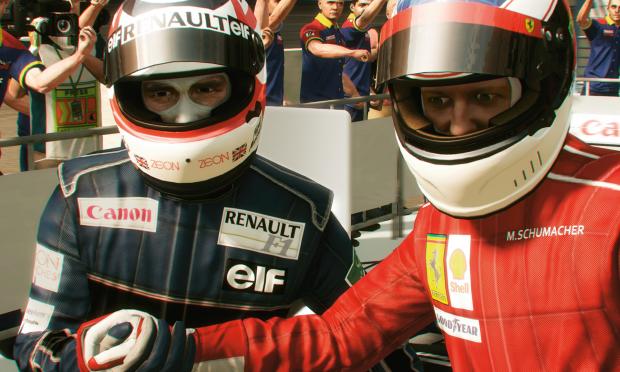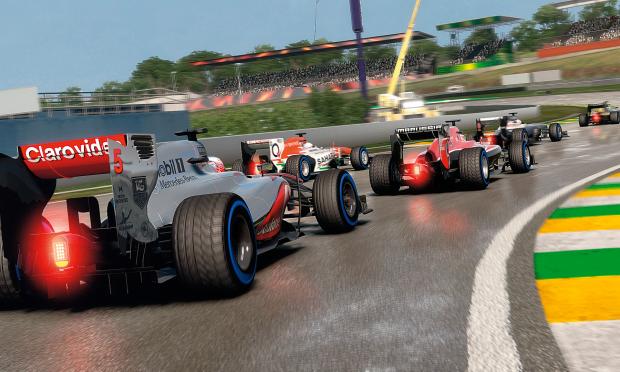F1 2013 Review
It is commonly accepted that most driving video games can be split into two distinct groups: arcade racers and simulations. Of course, there are varieties in between, but games usually tend to skew one way or the other. In the case of F1 2013, if one on the scale was most arcade-like, and ten was the most realistic simulation, this game would probably sit somewhere around fifteen. This is a note to a large proportion of racing fans: F1 2013 is merciless and demanding – you have been warned.
The game may well have a newly-added difficulty curve, with five different levels to choose from and a whole host of driver assists such as braking control, visual racing line and automatic gearboxes, but it remains a challenge even on the lower settings. Much like a real Formula One race, every small detail is important, and a bad start can spell disaster as recovery can prove thoroughly difficult. This isn’t a game where you can coast around corners and survive buffeting from other racers, as this will quickly result in you spinning off the track or losing an important part of your car, which, understandably, will seriously hamper your chances.
The game is as much about patience and self-control as understanding the sport, especially as you begin to take part in a proper career and choose to drive in longer races that more closely resemble the length of a real F1 race. Knowing that the car needs to be eased around the track in general, and only pushed hard in certain places and at the right times, is paramount to success. And when you also have to factor in new technological advances such as the deployment of the KERS or DRS systems that supply a little speed burst, and the new tyre usage rules from the 2013 season, you can see that just one bad choice could spell disaster further down the line.

That isn’t to say that the controls or the handling of the cars is unfair in any way – there are just techniques and nuances that must be studied and learned in order to get the best performance and results. This is helped by the instant replay and rewind options, which ensure that a perfect race won’t be ruined by a one momentary lapse. This godsend allows you to review the last twenty seconds or so, and rewind to any point within that time, which will hopefully allow you to avoid a big collision or a disastrous skid, for example. This can only be performed four times in each race, but used carefully it can minimise the frustration created by the inch-perfect driving demands.
The real revelation this time around – aside from the obvious new team updates and rules that apply to the real-world Formula One season – is the addition of Classics Mode. In this mode, you are treated to a selection of the best cars, drivers and tracks from the 1980s (and 90s, if you choose to buy the special Classics edition or purchase it separately as DLC). Introduced by F1′s legendary commentator Murray Walker, the mode allows for classic races and scenarios, but also for gamers to pit the champions of yesteryear against the current crop of drivers. The cars obviously handle quite differently to modern ones, and so another set of cars must be felt-out and learned if you want to succeed in Classics Mode.
The Scenario Mode is a new addition entirely, allowing you to take on pre-set objectives and set-ups. For instance, one set of scenarios follows the career of a rookie driver, facing many of the new challenges that a fresh entry into F1 would have to faqce, such as finishing a race from the back of the grid ahead of your teammate, or managing to maintain a podium position after your car has suffered heavy damage. These add a certain extra tension and drama to the races, as if the unforgiving controls didn’t already have you nervous enough.

Thankfully, before you tackle all of these modes, or the full length Grand Prix races or the Career Mode where you take your rookie driver through five years in the sport, there is a fairly comprehensive training mode to complete. Called New Driver Training, it plays the part of auditioning for your new team in career mode, trying to show what you can do in the car, when in actuality you are just learning and practicing all the basic in-race techniques. These can all be completed to bronze, silver or gold standard, so you’ll know just how ready you are for the main game after working your way through them.
There are actually two variations on the Career Mode; firstly, you have the “Full Career”, wherein you start from the bottom with a slow car, at a lowly team, with low expectations. This is the complete racing mode, which includes team negotiations and switching alliances as you move from season to season. This is all about striving for a top contract and a better drive – until you’re in the position to challenge for silverware. Secondly, there is the slightly lighter “Career Challenge” mode. Here, you take over the role of an established racer in whichever team you wish, and over the course of the season pick rivals who then must be bettered over the course of three or four races, all while you’re trying to win the championship too.
Probably the greatest innovation in the title this year, despite the new modes and the realistic rule enforcement and tyre degradation, is the ability for gamers to save their progress mid race. For a game that takes itself so seriously and is all about the millimeters between victory or defeat, being able to take a break when you need to is greatly appreciated. You can literally save mid-lap, whether it be in practice, qualification or the full race (only in Grand Prix and Career Mode; not within Scenarios, Time Trials or multiplayer), and resume from that exact point at a later time. This is especially handy if you’ve chosen to race full-length races, some of which have in excess of seventy laps.

This new option, along with the variety of game modes (which are complimented further by local split-screen, system link and online multiplayer, as well as leaderboard and ghost-enabled time trials) results in a good balance for fans who want to re-create the weekly progression of the real F1 season as accurately as possible, and for those who are looking to just jump in and out for some shorter gameplay bursts. Multiplayer starts as simple as one-off races, but goes all the way up to a full co-op career, where you and a friend lead an F1 team to glory. Improvements in the presentation and graphical performance further bring the title closer to reality – but it doesn’t reach the visual peaks that titles such as Gran Turismo or Forza Motorsport have achieved. Despite this, there is a lot of new content here that means F1 2013 stands head and shoulders above its predecessor.
VERDICT: The fact remains that F1 2013 is all about the in-depth replication of the real driving experience, and this will not appeal to every racing game fan. The game really demands that you invest a lot of time in it before you see your labour bear significant fruit. Of course, seasoned players coming from previous iterations will be able to pick things up more easily, and this is perhaps who the title is aimed at. Those fans will find much to appreciate, as what F1 2013 does, it does with a great level of detail and precision.
It is unlikely to pull in many new fans, though, as the difficulty curve is steep and unforgiving, but that isn’t what Codemasters are looking to achieve here. The changes made to save systems and replays do help to greatly reduce frustration, and the difficulty and specialisation certainly aren’t negative marks – especially in this era where too many games hold the player’s hand far too much. However, it seems likely that F1 2013 will remain the pastime of the few – as does the sport of Formula One in general. Those who seek it out and can get to grips with it, will love it – those who cannot will, unfortunately, be left a little cold.

VERY GOOD. An 8/10 is only awarded to a game we consider truly worthy of your hard-earned cash. This game is only held back by a smattering of minor or middling issues and comes highly recommended.




